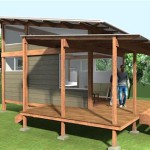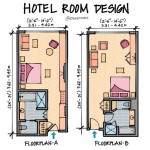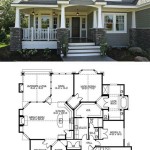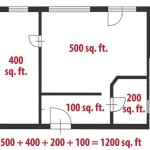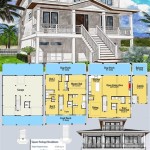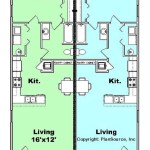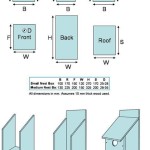Simple 1 Bedroom Apartment Floor Plans With Dimensions
A 1-bedroom apartment offers a compact and functional living space ideal for individuals, couples, or those seeking a minimalist lifestyle. Understanding the dimensions and layouts of different floor plans is crucial for maximizing the utility and comfort of this type of dwelling. This article delves into various simple 1-bedroom apartment floor plans, examining their key features, typical dimensions, and considerations for optimizing space utilization. We will analyze various design options, focusing on practical layouts and highlighting potential advantages and disadvantages regarding each layout.
Before exploring specific floor plans, it is important to understand the standard dimensions associated with a 1-bedroom apartment. While sizes can vary considerably based on location, building type, and construction era, a typical 1-bedroom apartment ranges from 500 to 750 square feet. This square footage needs to accommodate a living area, a bedroom, a kitchen (which might be separated or integrated with the living area), a bathroom, and potentially a small dining area or storage space. Optimizing the use of this space requires careful planning and consideration of furniture placement and storage solutions.
Key Considerations for 1-Bedroom Apartment Floor Plans
Several key factors influence the suitability of a particular 1-bedroom apartment floor plan. These factors include the individual's lifestyle, their needs in terms of storage and functionality, and their aesthetic preferences. Evaluating these aspects is essential for choosing a floor plan that promotes comfortable and efficient living.
Firstly, consider the flow of the apartment. A well-designed floor plan should feature a logical progression from one area to another, minimizing wasted space and awkward transitions. The layout should promote ease of movement and accessibility to all areas. For example, a direct line of sight and access between the kitchen and living area can be advantageous for individuals who entertain guests frequently, while a more secluded bedroom might be preferable for those who prioritize privacy and quiet.
Secondly, storage space is a critical consideration. One-bedroom apartments typically have limited storage capacity, making it imperative to maximize every available nook and cranny. Built-in shelves, under-bed storage, and multi-functional furniture are valuable assets in a small space. Look for floor plans that incorporate ample closet space, pantry storage, or additional storage areas. Vertical storage solutions, such as tall bookshelves and wall-mounted shelves, can help to free up valuable floor space.
Thirdly, the layout of the kitchen and bathroom deserves careful attention. In many 1-bedroom apartments, the kitchen is integrated into the living area, often in an open-concept design. This can create a sense of spaciousness and facilitate social interaction, but it also requires diligent upkeep to maintain cleanliness and prevent cooking odors from permeating the entire apartment. The bathroom should be functional and well-ventilated, with adequate space for essential fixtures and storage. Consider the placement of the toilet, sink, and shower or bathtub to ensure a comfortable and efficient layout.
Common 1-Bedroom Apartment Floor Plan Layouts
Several distinct layouts characterize 1-bedroom apartment floor plans. Each layout offers a unique configuration of space and presents different opportunities and challenges in terms of functionality and aesthetics. Understanding the defining features of each layout is essential for making an informed decision when selecting an apartment.
The Linear Layout: This layout features a straight line configuration, often with the entrance leading directly into the living area. The kitchen is typically located along one wall, adjacent to the living area. The bedroom is often situated at the end of the linear space, providing a degree of privacy. The bathroom is generally located either near the entrance or between the living area and the bedroom.
This layout often maximizes the use of wall space, making it suitable for apartments with long, narrow dimensions. Furniture placement is relatively straightforward, with furnishings arranged along the walls. However, the linear configuration can feel somewhat restrictive, particularly if the apartment is not sufficiently wide. The dimensions might be something along the lines of: Total Length: 40 feet, Total width: 15 feet, Living area: 15 feet x 12 feet, Bedroom: 12 feet x 10 feet, Kitchen: 8 feet x 8 feet, Bathroom: 5 feet x 7 feet. These dimensions are approximate and can vary significantly.
The L-Shaped Layout: This layout features an L-shaped configuration, with the living area and kitchen forming one leg of the "L" and the bedroom and bathroom forming the other. This configuration can create a greater sense of separation between the living and sleeping areas, offering enhanced privacy for the bedroom. The kitchen can be either open to the living area or slightly separated, depending on the specific design.
The L-shaped layout often lends itself to a more dynamic and visually interesting design. The L-shape can create a natural flow within the apartment. However, this layout can also present challenges in terms of furniture placement. The corners of the "L" might be awkward to furnish, requiring careful consideration of scale and proportion. Dimension examples: Total Length: 30 feet, Total width: 25 feet, Living area: 15 feet x 15 feet, Bedroom: 12 feet x 10 feet, Kitchen: 8 feet x 10 feet, Bathroom: 5 feet x 7 feet.
The Open-Concept Layout: This increasingly popular layout features minimal separation between the living area, kitchen, and dining area. The bedroom and bathroom are typically separated from the main living space by a hallway or a partition. The open-concept design promotes a sense of spaciousness and encourages social interaction. It is well-suited for individuals who enjoy entertaining guests or who prefer a more contemporary and minimalist aesthetic.
The open-concept layout requires a high degree of organization and cleanliness to maintain a cohesive and aesthetically pleasing appearance. It is important to define distinct zones within the open space through the use of furniture arrangement, rugs, and lighting. Storage solutions are particularly important in an open-concept apartment to avoid clutter. The dimensions are typically more generous in an open-concept apartment. For example: Total Length: 35 feet, Total Width: 22 feet. Living Area/Kitchen/Dining: 20 feet x 20 feet. Bedroom: 12 feet x 12 feet, Bathroom: 6 feet x 8 feet.
Dimensions and Spatial Arrangement
Understanding the dimensions of each room within the apartment is critical for planning furniture placement and ensuring comfortable circulation. The following provides a general indication of typical room sizes in a 1-bedroom apartment. However, it is vital to consult the specific floor plan of the apartment under consideration to obtain accurate dimensions.
Living Area: The living area typically ranges from 150 to 250 square feet. This space needs to accommodate seating, a coffee table, a television or entertainment center, and potentially a small dining table. The dimensions are crucial for determining the size and arrangement of furniture. A smaller living area might necessitate the use of space-saving furniture, such as a sectional sofa or a folding dining table. A larger living area offers greater flexibility in terms of furniture arrangement and allows for more elaborate design schemes.
Bedroom: The bedroom typically ranges from 100 to 150 square feet. This space needs to accommodate a bed, a nightstand, a dresser, and potentially a small desk or reading chair. The dimensions are crucial for determining the size of the bed and the placement of other furniture. A smaller bedroom might necessitate the use of a smaller bed, such as a full-size bed, or the elimination of some furniture altogether. A larger bedroom offers greater flexibility in terms of furniture arrangement and allows for more storage options.
Kitchen: The kitchen can vary significantly in size and configuration, depending on the specific floor plan. In some apartments, the kitchen is a small, galley-style space, while in others, it is a larger, open-concept area. The kitchen needs to accommodate essential appliances, such as a refrigerator, stove, and oven, as well as counter space for food preparation and storage for cookware and utensils. The dimensions of the kitchen are crucial for determining the type and size of appliances that can be accommodated.
Bathroom: The bathroom is typically the smallest room in the apartment, ranging from 30 to 50 square feet. This space needs to accommodate a toilet, sink, and shower or bathtub. The dimensions are crucial for ensuring that the fixtures are properly spaced and that there is sufficient room to move around comfortably. Wall-mounted sinks and toilets can help to save space in a small bathroom.
Optimizing Space in a Small Apartment
Living in a 1-bedroom apartment often requires creative strategies for maximizing space and functionality. Several techniques can be employed to make the most of limited square footage. These techniques include using multi-functional furniture, incorporating vertical storage solutions, and minimizing clutter.
Multi-Functional Furniture: Furniture that serves multiple purposes is a valuable asset in a small apartment. Examples of multi-functional furniture include sofa beds, storage ottomans, dining tables that can be folded away when not in use, and beds with built-in storage drawers. These pieces can significantly reduce clutter and free up valuable floor space.
Vertical Storage Solutions: Utilizing vertical space is essential for maximizing storage capacity in a small apartment. Tall bookshelves, wall-mounted shelves, and over-the-door organizers can provide ample storage without taking up valuable floor space. Hanging clothes rods and shelves in closets can also help to maximize storage efficiency.
Minimizing Clutter: Clutter is the enemy of small space living. Regularly decluttering the apartment and getting rid of unnecessary items is essential for maintaining a sense of order and spaciousness. Storing seasonal items and rarely used belongings in storage units or other off-site locations can also help to reduce clutter. Implementing effective organizational systems, such as using labeled containers and baskets, can help to keep belongings neatly stored and easily accessible.
In conclusion, selecting a suitable 1-bedroom apartment floor plan requires careful consideration of individual needs, lifestyle, and aesthetic preferences. Understanding the different layout options, typical dimensions, and strategies for optimizing space is crucial for creating a comfortable and functional living environment. By carefully analyzing the floor plan and implementing smart design solutions, it is possible to transform a small apartment into a stylish and efficient home.

Studio Apartment Floor Plans Google Search

House Plans Under 500 Square Feet

Small House Plans Studio One Bedroom 1

Krug Stylish And Simple One Bedroom Atlanta Apartments

1 Bedroom Adu Floor Plans Designs Layouts Exteriors

Typical Floor Plan One Bedroom

1 Bedroom Apartment Floor Plan

24x32 House 1 Bedroom Bath 768 Sq Ft Floor Plan Instant Model 1a

1 2 Bedroom Floor Plans In Maple Grove Mn Tylia Apartments

Central Park West One Bedroom Floor Plans
Related Posts

